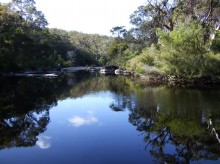Marion talks about York and the surrounding area where she was brought up and her family have been living for generations.
I am so fortunate to have been taught by my father and other members of his family about my country. This knowledge has enhanced my strong connection to country making me feel a part of it and it a part of me.
 My country is the small town of York and surrounding areas. York is the oldest inland town in Western Australia and is located 100 kilometres east of Perth.
My country is the small town of York and surrounding areas. York is the oldest inland town in Western Australia and is located 100 kilometres east of Perth.
Ensign Robert Dale is said to have discovered York in 1831 (Hallam, 1998). Of course, he was the first white man to discover York, as it had been discovered thousands and thousands of years prior to 1831 by the Noongar people.
My father often spoke of our country. This was our traditional land and our family had been there for generations. It was our country and not too many Noongars can say where their original family came from.
My father spoke of Beverley, York, Quairading, Kellerberrin, Northam and Toodyay as being land of the Ballardong (language group for these areas) people. However, he would say the Kicketts belonged to Beverley, York, Quairading, the lakes and Sawyers Valley right down to Mundaring.
This oral history is supported by Bishop Rosendo Salvado who had a great deal to do with Aboriginal people around New Norcia and surrounding areas including the Avon Valley around Toodyay.
‘Every individual has his own territory for hunting, gathering gum and picking up yams, and the rights he has here are respected as sacred. I have often heard them say in dispute – even to their friends – Nichia n —agna cala …’ (‘this is my district, yours is… get out of here straight away’). Consequently each particular family regards one particular district as belonging exclusively to itself, though the use of it is freely shared by nearby friendly families…’ (Salvado, 1851: cited in Stormon 1977, p 130–131)
My father called this part of our country ‘our run’. Birdsall acknowledges the term stating: ‘The long family association with the region in which they live is called by Nyungars a ‘run’. It is a set of towns used by the family and is a product of family history.’ (Birdsall, 1990, p 182).
My grandfather, Thomas Kickett Junior, moved between certain towns and the bush (his run) to prevent his children from being removed to a mission. However, in 1932 he made the decision to stay permanently on the reserve in York.
The land allocated for the purpose of a native reserve in York was in fact a traditional camping site of the Kickett family. My grandfather had a strong connection to this site, as he had stayed there on many occasions with his parents for most of his young life. My father informed me that there were many other camping sites throughout their run. However, most of these traditional camping sites were no longer available to the Ballardong people.
As a child, my father told me the dreaming stories of York and surrounding areas. He knew them all as he had been told these stories over and over from a young age. I was often told about the burning of the undergrowth. My father called it farming kangaroos. He would laugh and say, ‘The white farmers farm sheep but Noongars farm kangaroos.”
When the undergrowth became thick it was burnt. This was part of taking care of the land and the people. The new sweet shoots of grass encouraged various animals to come and feed making it easier for them to be hunted.
I was always amazed at such stories and I remember asking when I was a bit older, how the fire never got away and caused a great bushfire. My father’s answer was, “The old people knew their environment they could read the weather pattern and they understood the seasons. They had the knowledge of how to light a fire and control it.” Early white settlers were certainly aware of such a practice and acknowledged the skill of Aboriginal people.
‘It is true we might ourselves burn the bush, but we could never do it with the same judgement and good effort as the natives, who keep the fire within due bounds, only burning those parts they wish when the scrub becomes too thick…’ (Bunbury, cited in Bunbury and Morrell, 1930, p 105)
I am so fortunate to have been taught by my father and other members of his family about my country. This knowledge has enhanced my strong connection to country making me feel a part of it and it a part of me. Such is the case with so many other Aboriginal people throughout Australia.
Miriam-Rose Ungunmerr-Baumann sums up my feelings very well by her statement:
‘My people could not read, they did not write. They remembered and they told and retold. Interest was always fresh like new discovery. The countryside was somehow part of me and I was part of it; it was filled with named places and I came to learn so many of them. It was my home it was me.’ (Miriam-Rose Ungunmerr-Baumann, 1986, p 13)


